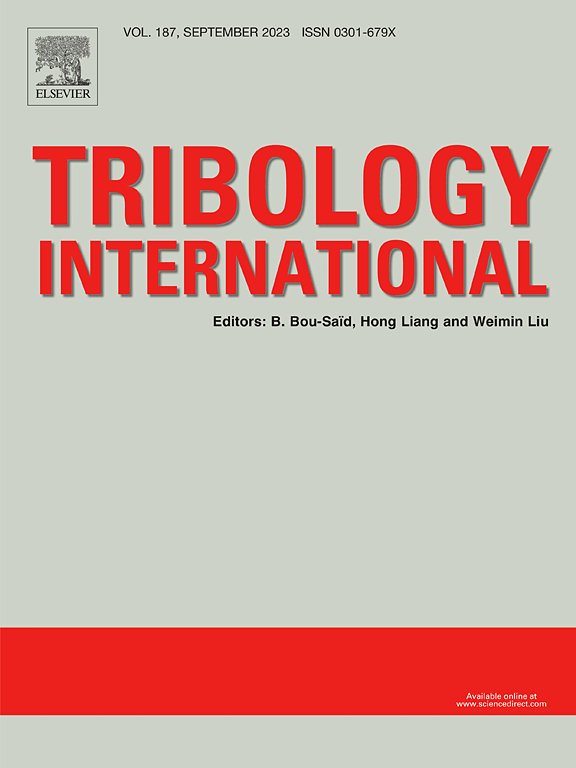aps喷涂CoCrNiW耐磨涂层和NiCoCrAlYTa/Cu/Mo自润滑涂层的高温摩擦学性能
IF 6.1
1区 工程技术
Q1 ENGINEERING, MECHANICAL
引用次数: 0
摘要
利用大气等离子喷涂技术,制备了CoCrNiW耐磨涂层和NiCoCrAlYTa/Cu/Mo自润滑复合涂层。研究了其显微组织、力学性能和高温摩擦学性能。结果表明,两种涂层均表现出优异的摩擦学性能。随着温度的升高,磨损率和摩擦系数(COF)先上升后下降。CoCrNiW和NiCoCrAlYTa/Cu/Mo涂层的COF分别为0.60 ~ 1.17和0.31 ~ 1.01,其磨损率分别为0.60 ~ 2.50 × 10 - 5 mm³/N·m和0.29 ~ 3.35 × 10 - 5 mm³/N·m。在600℃时,CoCrNiW涂层的磨损轨迹表面被釉层覆盖,磨损机制由磨粒磨损转变为粘着磨损,随着温度的升高,磨损程度降低。相比之下,niccralyta /Cu/Mo复合涂层在800℃时形成了含有自润滑相的釉层,有效地减少了磨料磨损,表现出比CoCrNiW涂层更好的耐磨性。本文章由计算机程序翻译,如有差异,请以英文原文为准。
High-temperature tribological properties of APS-sprayed CoCrNiW wear-resistant coating and NiCoCrAlYTa/Cu/Mo self-lubricating coating
Utilizing atmospheric plasma spraying technology, we produced wear-resistant coatings of CoCrNiW and NiCoCrAlYTa/Cu/Mo self-lubricating composite coatings. The microstructures, mechanical properties, and high-temperature tribological properties were studied. The findings showed that both coatings demonstrated excellent tribological properties. As the temperature increased, the wear rate and coefficient of friction (COF) first rose and then fell. The COF for the CoCrNiW and NiCoCrAlYTa/Cu/Mo coatings were measured at 0.60 to 1.17 and 0.31 to 1.01, respectively, while their wear rates were found to be 0.60 to 2.50 × 10⁻5 mm³/N·m and 0.29 to 3.35 × 10⁻5 mm³/N·m. At 600 ℃, the wear track surface of the CoCrNiW coating was covered by a glaze layer, and the wear mechanism shifted from abrasive wear to adhesive wear, thereby reducing wear severity as the temperature rose. In contrast, the NiCoCrAlYTa/Cu/Mo composite coating developed a glaze layer containing self-lubricating phases at 800 ℃, effectively diminishing abrasive wear, thus showing better wear resistance than CoCrNiW coating.
求助全文
通过发布文献求助,成功后即可免费获取论文全文。
去求助
来源期刊

Tribology International
工程技术-工程:机械
CiteScore
10.10
自引率
16.10%
发文量
627
审稿时长
35 days
期刊介绍:
Tribology is the science of rubbing surfaces and contributes to every facet of our everyday life, from live cell friction to engine lubrication and seismology. As such tribology is truly multidisciplinary and this extraordinary breadth of scientific interest is reflected in the scope of Tribology International.
Tribology International seeks to publish original research papers of the highest scientific quality to provide an archival resource for scientists from all backgrounds. Written contributions are invited reporting experimental and modelling studies both in established areas of tribology and emerging fields. Scientific topics include the physics or chemistry of tribo-surfaces, bio-tribology, surface engineering and materials, contact mechanics, nano-tribology, lubricants and hydrodynamic lubrication.
 求助内容:
求助内容: 应助结果提醒方式:
应助结果提醒方式:


